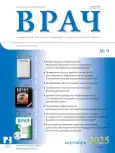Выбор метода обезболивания передней брюшной стенки у пациенток после оперативного родоразрешения
- Авторы: Ильичев Р.И.1, Кузовлев А.Н.1, Долгих В.Т.1
-
Учреждения:
- Федеральный научно-клинический центр реаниматологии и реабилитологии
- Выпуск: Том 36, № 9 (2025)
- Страницы: 5-12
- Раздел: Актуальная тема
- URL: https://journal-vniispk.ru/0236-3054/article/view/315144
- DOI: https://doi.org/10.29296/25877305-2025-09-01
- ID: 315144
Цитировать
Аннотация
Цель. Обосновать оптимальный выбор мультимодального обезболивания пациенток в раннем восстановительном периоде после оперативного родоразрешения для улучшения реабилитации, уменьшения осложнений и повышения качества жизни родильниц и новорожденных.
Материал и методы. Проведен анализ данных клинического обследования, результатов лабораторных и инструментальных методов диагностики и динамического наблюдения 310 родильниц и новорожденных. Пациентки и новорожденные были разделены на три группы. В основной группе (n=112) роженицам выполняли кесарево сечение под эпидуральной анестезией, которую пролонгировали в первые трое суток послеоперационного периода. В группе сравнения (n=95) операцию проводили под комбинированной спинально-эпидуральной анестезией, в первые трое суток послеоперационного периода применяли пролонгированную эпидуральную анестезию. В контрольной группе (n=103) операцию выполняли под эпидуральной анестезией, в послеоперационном периоде для обезболивания использовали нестероидные противовоспалительные препараты (НПВП).
Результаты. Установлено, что сочетание эпидуральной анестезии в родах и пролонгированной эпидуральной анестезии ропивокаином в первые трое суток после кесарева сечения обладает более сильным анальгезирующим эффектом по сравнению с сочетанием комбинированной спинально-эпидуральной анестезии бипувакаина в родах и пролонгированной анестезией ропивокаина в послеродовом периоде, а также по сравнению с сочетанием эпидуральной анестезии ропивокаина в родах и НПВП в первые трое суток послеоперационного периода. Пролонгированная эпидуральная анестезия значительно снижала уровень гормонов стресса как у матери, так и у новорожденного на протяжении первых 24 ч после операции и не оказывала негативного влияния на новорожденного.
Полный текст
Открыть статью на сайте журналаОб авторах
Р. И. Ильичев
Федеральный научно-клинический центр реаниматологии и реабилитологии
Email: prof_dolgih@mail.ru
ORCID iD: 0009-0002-4420-2440
SPIN-код: 9728-2833
Россия, Москва
А. Н. Кузовлев
Федеральный научно-клинический центр реаниматологии и реабилитологии
Email: prof_dolgih@mail.ru
ORCID iD: 0000-0002-5930-0118
SPIN-код: 8648-3771
доктор медицинских наук
Россия, МоскваВ. Т. Долгих
Федеральный научно-клинический центр реаниматологии и реабилитологии
Автор, ответственный за переписку.
Email: prof_dolgih@mail.ru
ORCID iD: 0000-0001-9034-4912
SPIN-код: 2052-1445
доктор медицинских наук, профессор
Россия, МоскваСписок литературы
- Yu H.Y., Wang S.Y., Quan C.X. et al. Dexmedetomidine Alleviates Postpartum Depressive Symptoms following Cesarean Section in Chinese Women: A Randomized Placebo-Controlled Study. Pharmacotherapy. 2019; 39 (10): 994–1004. doi: 10.1002/phar.2320
- Tamura T., Yokota S., Ando V. et al. A triple-blinded randomized trial comparing spinal morphine with posterior quadratus lumborum block after cesarean section. Int J Obstet Anesth. 2019; 40: 32–8. doi: 10.1016/j.ijoa.2019.06.008
- Macones G.A., Caughey A.B., Wood S.L. Guidelines for postoperative care in cesarean delivery: Enhanced Recovery After Surgery (ERAS) Society recommendations (part 3). Am J Obstet Gynecol. 2019; 221 (3): 247.e1-247.e9. doi: 10.1016/j.ajog.2019.04.012
- Manou-Stathopoulou V., Korbonits V., Ackland G.I. Redefining the perioperative stress response: a narrative review. Br J Anaesth. 2019; 123 (5): 570–83. doi: 10.1016/j.bja.2019.08.011
- Levene J.L., Weinstein E.J., Cohen M.S. et al. Local anesthetics and regional anesthesia versus conventional analgesia for preventing persistent postoperative pain in adults and children: A Cochrane systematic review and meta-analysis update. J Clin Anesth. 2019; 55: 116–27. doi: 10.1016/j.jclinane.2018.12.043
- Багомедов Р.Г., Омарова Х.М. Различные виды анестезии при операции «кесарево сечение» (обзор литературы). Вестник новых медицинских технологий. 2015; 22 (1): 87–93 [Bogomedov R.G., Omarova Kh.M. Various types of anesthesia during caesarean section (literature review). Vestnik novikh medicinskikh trkhnologiyi. 2015; 22 (1): 87–93 (in Russ.)]
- Шейбак Л.Н. Современные подходы к диагностике гипогликемии у новорожденных. Медицинские новости. 2016; 6: 25–8 [Sheibak L.N. Modern approaches to the diagnosis of hypoglycemia in newborns. Medicinskie novosti. 2016; 6: 25–8 (in Russ.)]
- Таштанбекова Ч.Б., Чуенкова Е.А., Евстратов А.А. и др. Управление болью при кесаревом сечении: использование и стоимость анестетиков и анальгетиков. Казанский медицинский журнал. 2020; 101 (3): 418–25 [Tashtanbekova C.B., Chuenkova E.A., Evstratov A.A., et al. Use and costs of pain management in cesarian section. Kazan medical journal. 2020; 101 (3): 418–25 (in Russ.)]. doi: 10.17816/KMJ2020-418
- Овечкин А.М. Послеоперационное обезболивание в акушерстве и гинекологии (аналитический обзор). Регионарная анестезия и лечение острой боли. 2014; 8 (2): 5–16 [Ovechkin A.M. Postoperative analgesia in obstetrics and gynecology: foreign guidelines and our reality. Regional Anesthesia and Acute Pain Management. 2014; 8 (2): 5–16 (in Russ.)]. doi: 10.17816/RA36203
- Aly M., Ibragim A., Farrag W. et al. Pruritus after intrathecal morphine for cesarean delivery: incidence, severity and its relation to serum serotonin level. Int J Obstet Anesth. 2018; 35: 52–6. doi: 10.1016/j.ijoa.2018.02.004
- Лядов К.В., Коваленко З.А., Лядов В.К. и др. Опыт внедрения программы ускоренной послеоперационной реабилитации (fast track) в хирургической панкреатологии. Вестник восстановительной медицины. 2014; 5: 21–5 [Lyadov K.V., Kovalenko Z.A., Lyadov V.K. et al. Fast track recovery pathways in pancreatic surgery. Bulletin of Rehabilitation Medicine. 2014; 5: 21–5 (in Russ.)]
- Фомин С.А., Александрович Ю.С., Фомина Е.А. Эволюция подходов к оценке боли у новорожденных. Неонатология: новости, мнения, обучение. 2018; 7 (1): 47–59 [Fomin S.A., Aleksandrovich Yu.S., Fomina E.A. Evolution of approaches to evaluation pain in newborns. Neonatology: News, Opinions, Training. 2018; 7 (1): 47–59 (in Russ.)]. doi: 10.24411/2308-2402-2018-00007
- Carvalho B., Butwick A.J. Post-Cesarean Delivery Analgesia. Best Pract Res Clin Anaesthesiol. 2017; 31 (1): 69–79. doi: 10.1016/j.bpa.2017.01.003
- Lee T.H., Qu Y., Telzer E.H. Dyadic neural similarity during stress in mother–child dyads. J Res Adolesc. 2018; 28 (1): 121–33. doi: 10.1111/jora.12334
- Овечкин А.М. Послеоперационная боль: состояние проблемы и современные тенденции послеоперационного обезболивания. Регионарная анестезия и лечение острой боли. 2015; 9 (2): 29–39 [Ovechkin A.V. Postoperative pain: the state of problem and current trends in postoperative analgesia. Regionarnaya anesteziya i lechenie ostroy boli. 2015; 9 (2): 29–39 (in Russ.)].
- Izadpanah A., Soorgi A., Geraminejad N. et al. Effect of grape seed extract ointment on cesarean section wound healing: A double-blind, randomized, controlled clinical trial. Complement Ther Clin Pract. 2019; 35: 323–8. doi: 10.1016/j.ctcp.2019.03.011
- Maple H., Chilcot J., Lee V. et al. Stress predicts the trajectory of wound healing in living kidney donors as measured by high-resolution ultrasound. Brain Behav Immun. 2015; 43: 19–26. doi: 10.1016/j.bbi.2014.06.012
Дополнительные файлы








